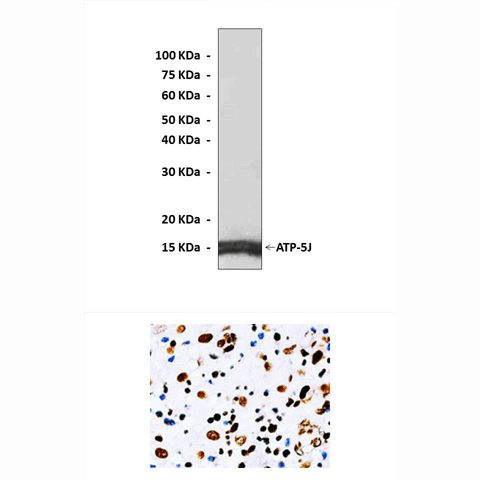Product Sheet CA1012
Description
BACKGROUND Mitochondrial adenosine triphosphate (ATP) synthase catalyzes ATP synthesis, utilizing an electrochemical gradient of protons across the inner membrane during oxidative phosphorylation. It is a supermolecule composed of at least 14 subunits that have a constant stoichiometry, six of which construct the catalytic site of ATP synthase known as F1 and eight of which construct an energy transduction part known as Fo. Coupling factor 6 (CF6), also known as ATP5J, is a component of Fo and is reported to be essential for energy transduction.1 CF6 is composed of 76 amino acids and is present in the peripheral stalk of mitochondrial ATP synthase. The generation of CF6 is positively regulated by tumor necrosis factor alpha and shear stress via nuclear factor kappaB, and by high glucose via protein kinase C and p38 mitogen-activated protein kinase. CF6 is released outside of the cells from vascular endothelial cells, and binds to the beta-subunit of the plasma membrane-bound ATP synthase in vascular endothelial cells and leads to intracellular acidosis. CF6 produces vasoconstriction, and the biological active site resides at the C-terminal portion. CF6 suppresses prostacyclin generation via inhibition of cytosolic phospholipase A2. CF6 also suppresses nitric oxide synthase activity via an increase in asymmetric dimethylarginine and a decrease in platelet/endothelial cell adhesion molecule-1. CF6 induces the gene and protein expression of proatherogenic molecules such as endothelin 2, urokinase type plasminogen activator receptor, estrogen receptor beta, a soluble short form of vascular endothelial growth factor receptor-1, and lectin-like oxidized low-density lipoprotein receptor-1. The plasma level of CF6 is elevated in patients with essential hypertension, diabetes mellitus, end-stage renal disease, acute myocardial infarction, and coronary heart disease. It is likely that CF6 contributes to the pathogenesis of cardiovascular diseases.2 It was demonstrated that CF6 causes hypertension by directly enhancing Ca2+ signaling via c-Src activation in the resistance arteriole VSMCs.3 Alternatively spliced transcript variants encoding different isoforms have been identified for this gene.
REFERENCES
1. Kinosita, K. Et al: Essays Biochem. 35:3–18, 2003
2. Tanaka, M. et al: J. Hypertens. 24:489-97, 2006
3. Osanai, T. et al: Cardiovasc. Res. 81:780-787, 2009
2. Tanaka, M. et al: J. Hypertens. 24:489-97, 2006
3. Osanai, T. et al: Cardiovasc. Res. 81:780-787, 2009
Products are for research use only. They are not intended for human, animal, or diagnostic applications.
Details
Cat.No.: | CA1012 |
Antigen: | Short peptide from human ATP-5J sequence. |
Isotype: | Rabbit IgG |
Species & predicted species cross- reactivity ( ): | Human, Rat |
Applications & Suggested starting dilutions:* | WB 1:1000 IP n/d IHC 1:50 - 1:200 ICC n/d FACS n/d |
Predicted Molecular Weight of protein: | 15 kDa |
Specificity/Sensitivity: | Detects endogenous levels of ATP-5J proteins without cross-reactivity with other family members. |
Storage: | Store at -20°C, 4°C for frequent use. Avoid repeated freeze-thaw cycles. |
*Optimal working dilutions must be determined by end user.

